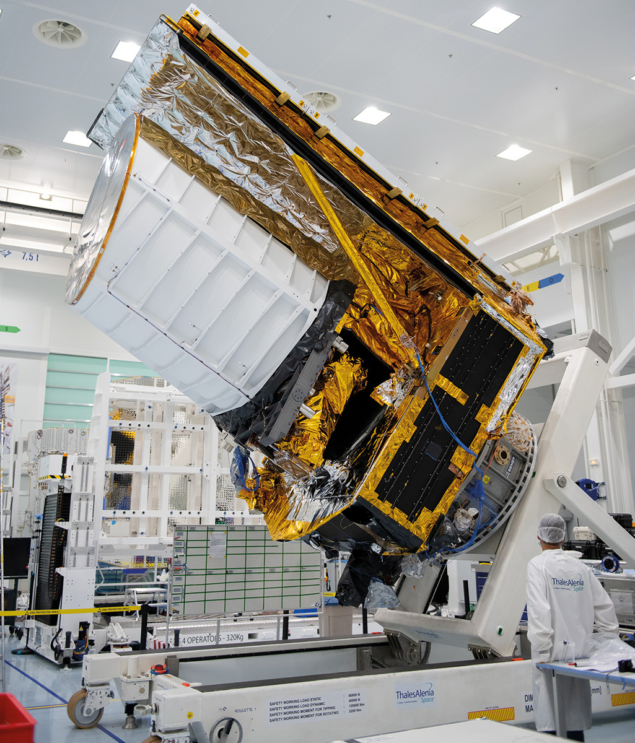
Untangling the evolution of the universe, in particular the nature of dark energy and dark matter, is a central challenge of modern physics. An ambitious new mission from the European Space Agency (ESA) called Euclid is preparing to investigate the expansion history of the universe and the growth of cosmic structures over the last 10 billion years, covering the entire period over which dark energy is thought to have played a significant role in the accelerating expansion. The 2 tonne, 4.5 m tall and 3.1 m diameter probe is undergoing final tests in Cannes, France, after which it will be shipped to Cape Canaveral in Florida and inserted into the faring of a SpaceX Falcon 9 rocket, with launch scheduled for July.
Let there be light
Euclid, which was selected by ESA for implementation in 2012 with a budget of about €600 million, has four main objectives. The first is to investigate whether dark energy is real, or whether the apparent acceleration of the universe is caused by a breakdown of general relativity on the largest scales. Second, if dark energy is real, Euclid will investigate whether it is a constant energy spread across space or a new force of nature that evolves with the expansion of the universe. A third objective is to investigate the nature of dark matter, the mass of neutrinos and whether there exist other, so-far undetected fast-moving particle species, and a fourth is to investigate statistics and properties of the early universe that seeded large-scale structures. To meet these goals, the six-year Euclid mission will use a three-mirror system to direct light from up to a billion galaxies across more than a third of the sky towards a visual imager for photometry and a near-infrared spectrophotometer.
So far, the best constraints on the geometry and expansion history of the universe come from cosmic-microwave background (CMB) surveys. Yet these missions are not the best tracers of the curvature, neutrino masses and expansion history, nor for identifying possible exotic subcomponents of dark matter. For this, large surveys on galaxy clustering are required. Euclid will use three methods to achieve this. The first is redshift-space distortions, which combines how fast galaxies move away from us due to the expansion of the universe and how fast galaxies move towards a region of strong gravitational pull in our line-of-sight; measuring these deformations in galactic positions enables the growth rate of structures as well as gravity to be investigated. The second is baryonic acoustic oscillations (BAOs), which arose when the universe was a plasma made from baryons and photons and set a characteristic scale that is related to the sound horizon at recombination. After recombination, photons decoupled from visible matter while baryons were pulled in by gravity and started to form bigger structures, with the BAO scale imprinted in galaxy distributions. BAOs thus serve as a ruler to trace the expansion rate of the universe. The third method, weak gravitational lensing, occurs when light from a background source is bent around a massive foreground object such as a galaxy cluster, from which the distribution of dark matter can be inferred.
As the breadth and precision of cosmological measurements increase, so do the links with particle physics. CERN and the Euclid Consortium (which consists of more than 2000 scientists from 300 institutes in 13 European countries, the US, Canada and Japan) signed a memorandum of understanding in 2016 after Euclid gained CERN recognised-experiment status in 2015. The collaboration was motivated by technical synergies for the mission’s Science Ground Segment (SGS), which will process about 850 Gbit of compressed data per day – the largest of any ESA mission to date. CERN is contributing with the provision of critical software tools and related support activities, explains CERN aerospace and environmental applications coordinator Enrico Chesta: “CernVM–FS, developed by the EP-SFT team to assist high-energy physics collaborations to deploy software on the distributed computing infrastructure used to run data-processing applications, has been integrated into Euclid SGS and will be used for software continuous deployment among the nine Euclid science data centres.”
Competitive survey
Euclid’s main scientific objectives also align closely with CERN’s physics challenges. A 2019 CERN-TH/Euclid workshop identified overlapping areas of interest and options for scientific visitor programmes, with topics of potential interest including N-body CMB simulations, redshift space distortions with relativistic effects, model selection of modified gravity, and dark-energy and neutrino-mass estimation from cosmic voids. Over the coming years, Euclid will provide researchers with data against which they can test different cosmological models. “Galaxy surveys have been happening for decades and have grown in scale, but we didn’t hear much about it because the CMB was, until now, more accurate,” says theorist Marko Simonović of CERN. “With Euclid there will be a competitive survey that is big enough to be comparable to CMB data. It is exciting to see what Euclid, and other new missions such as DESI, will tell us about cosmology. And maybe we will even discover something new.”







